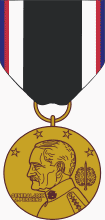Army of Occupation of Germany Medal
The Army of Occupation of Germany Medal is a service medal of the United States military which was created by the (55 Stat. 781) act of the United States Congress on November 21, 1941. The medal recognizes those members of the United States military who served in the European occupation force following the close of World War I.[1]
| Army of Occupation of Germany Medal | |
|---|---|
 | |
| Awarded by Department of War | |
| Type | Service medal |
| Eligibility | 1918–1923 (retroactive) |
| Awarded for | service in the post-World War I occupation force |
| Statistics | |
| Established | 21 November 1941 |
| First awarded | 12 November 1918 (retroactive) |
| Last awarded | 11 July 1923 (retroactive) |
Service ribbon and streamer | |
The medal is retroactive by design and is awarded to any service member who performed occupation garrison duty in either Germany, or the former Austria-Hungary, between the dates of November 12, 1918 and July 11, 1923. The medal was primarily created due to the rising tension with Germany, between 1939 and 1941, and also as a means to honor the World War I service of General of the Armies John J. Pershing, whose likeness appears on the actual medal. Initially the blue edge stripe was wavy, to signify the Rhine River, but that proved impractical to mass produce and was changed to a straight line.[2]
The first Army of Occupation of Germany Medal was presented to General of the Armies Pershing, with retroactive presentations made to any service member upon application to the United States War Department. Less than three weeks after the medal was first authorized, the United States was attacked at Pearl Harbor which led to another full-scale war with Germany, now allied with Japan. [3]
References
- "Institute of Heraldry Army Occupation of Germany". Archived from the original on 2011-10-25. Retrieved 2011-06-05.
- "Army of Occupation of Germany Medal". edocket.access.gpo.gov. Retrieved 2018-03-12.
- Foxfall. "Army of Occupation of Germany Medal". www.foxfall.com. Retrieved 2018-03-12.
| Wikimedia Commons has media related to Army of Occupation of Germany Medal. |